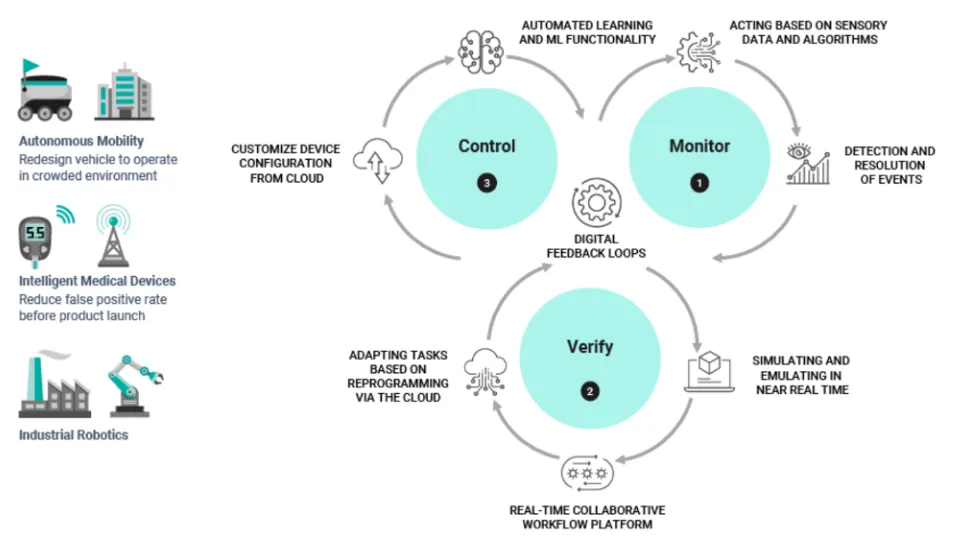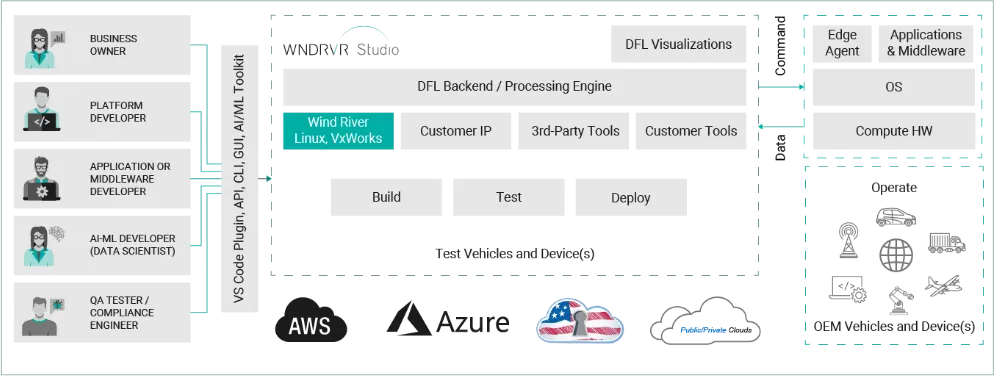What Is a Digital Feedback Loop?
A digital feedback loop is a cyclical process that involves collecting, analyzing, and applying feedback from digital sources to drive continuous improvement. It revolves around the idea of harnessing data from various digital channels (such as websites, mobile apps, social media platforms, and email) to gain valuable insights and make informed decisions.
This iterative process allows organizations to refine their offerings, optimize customer experiences, and stay ahead in the competitive landscape with:

- Data collection: The first step in the digital feedback loop is the collection of feedback. This can be done through surveys, ratings, reviews, comments, or interactive tools available on digital platforms. Organizations actively seek feedback from customers, employees, and other stakeholders to gather information about their experiences, preferences, and pain points.
- Analysis: Once the feedback is collected, it undergoes analysis and interpretation. Advanced analytics tools and techniques are employed to extract meaningful insights from the data. Natural language processing and sentiment analysis help organizations understand the attitudes and context behind the feedback, enabling them to identify patterns, emerging trends, and possible improvements.
- Action: After analyzing the feedback, organizations take action based on the insights gained. This involves identifying specific areas that require attention, developing strategies, and implementing changes to enhance products, services, or processes.
The digital feedback loop empowers businesses to make data-driven decisions, ensuring that improvements are targeted and effective. The process doesn’t end with a single iteration; it is designed to be continuous, with each cycle building upon the previous one. Feedback is collected, analyzed, and acted upon repeatedly, allowing organizations to continuously refine their offerings, adapt to changing customer needs, and drive innovation.
Key Components of a Digital Feedback Loop
Feedback collection: The digital feedback loop begins with the collection of feedback from various digital channels and touchpoints. These channels can include websites, mobile apps, social media platforms, email, surveys, online reviews, and customer support interactions. The collection process involves capturing feedback in the form of ratings, reviews, comments, suggestions, or direct messages.
Data aggregation and analysis: This step involves organizing and categorizing the feedback data, applying analytics techniques, and leveraging tools such as natural language processing and sentiment analysis. The goal is to gain a comprehensive understanding of the feedback and identify trends, patterns, and areas for improvement.

The digital feedback loop is an ongoing process of capturing and acting upon feedback from digital channels.
Insight generation: After analyzing the feedback data, insights are generated concerning customer sentiment and identification of product/service issues, strengths and weaknesses, and opportunities for innovation. These insights provide valuable information about customer preferences, pain points, satisfaction levels, and emerging trends.
Action planning: Based on the insights gained, organizations need to develop action plans. This involves determining the necessary steps to address the feedback and improve products, services, or processes. Action planning may include setting priorities, defining goals, allocating resources, and establishing timelines. The action plan should be aligned with the feedback received and with the organization’s strategic objectives.
Implementation and iteration: The next step is the implementation of the action plan. This involves making the necessary changes or improvements based on the feedback and insights. That could mean modifying product features, enhancing customer support processes, optimizing user interfaces, or refining marketing strategies. The implementation is itself an iterative process, with feedback continuously monitored and adjustments made to drive ongoing improvement.
Feedback communication: Once changes or improvements are implemented, it is essential to communicate the outcomes to customers, employees, or other relevant stakeholders. Feedback communication can occur through digital channels such as email, social media updates, blog posts, or in-app notifications. Transparent and timely communication helps build trust, demonstrate responsiveness, and show the impact of feedback in driving positive change.
Continuous monitoring and measurement: The digital feedback loop is an ongoing process, and ongoing monitoring is crucial to its success. Organizations need to continuously collect, analyze, and act upon feedback to ensure a consistent flow of insights. It is essential to establish key performance indicators (KPIs) and metrics to measure the effectiveness of the feedback loop and track progress over time.
By incorporating these steps into the digital feedback loop, organizations can create a structured process that allows them to effectively gather, analyze, and act upon feedback. This iterative approach fosters continuous improvement, enhances customer satisfaction, drives innovation, and enables organizations to be responsive and adaptive in the digital landscape.
The Importance of Implementing a Digital Feedback Loop
Implementing a digital feedback loop brings significant benefits to organizations:
A customer-centric approach: By actively listening to and understanding customer feedback, organizations can tailor products, services, and experiences to better meet expectations, leading to improved customer satisfaction and loyalty.
Continuous improvement: Through feedback analysis and action planning, organizations can make data-driven decisions to push iterative improvements in products, services, and processes. This constant focus on improvement enables organizations to stay ahead of the competition and deliver better value to customers.
Innovation and differentiation: By actively soliciting feedback and analyzing trends, organizations can uncover unmet needs and push product or service enhancements, new features, or entirely new offerings. Implementing a digital feedback loop helps organizations differentiate themselves in the market and remain relevant in a rapidly evolving landscape.

Organizations benefit from the digital feedback loop’s engagement with customers, individual employees, and teams.
Employee engagement and empowerment: Involving employees in the feedback loop fosters a culture of engagement, collaboration, and empowerment. Employees can provide valuable insights into operational inefficiencies and customer pain points. By incorporating that feedback, organizations can leverage the collective knowledge and experience of their workforce to drive improvements and streamline operations.
Data-driven decision-making: The digital feedback loop provides organizations with valuable data. By analyzing it, organizations can make informed decisions based on customer sentiments, preferences, and market trends. This data-driven approach reduces reliance on assumptions or guesswork, resulting in more accurate and effective decision-making.
Brand reputation and customer trust: When customers see that their feedback is being acknowledged and acted upon, it builds trust and enhances the organization’s brand reputation. Customers are more likely to engage with organizations that actively seek feedback, leading to stronger customer relationships and positive word-of-mouth referrals.
Agile response to market changes: The digital feedback loop enables organizations to monitor feedback in real time, identify emerging trends, and quickly adapt strategies or offerings to meet evolving customer needs. This agility helps organizations stay ahead of competitors and capitalize on emerging opportunities.
How Can Wind River Help?
Wind River Simics
Wind River® Simics® supports digital feedback loops in conjunction with a virtual machine or system to maintain a persistent record of the machine state (irrespective of connectivity) and of the model machine state through simulation. Explore “what if” scenarios in a virtual environment before working on real hardware, with geographically dispersed teams anywhere in the world.
» Learn More About Digital Twins» Learn More About Simics
Wind River Studio
Wind River Studio provides digital feedback loop solutions. Define, embed, and share data including telemetry, logs, images, and events from edge devices at scale. Collect and integrate metadata and telemetry data from deployed systems to provide curated real-time insights to optimize performance, features, and user behavior across these systems. Studio closes the feedback loop with a role-based command console to trigger manual or automated responses such as device rebooting, power cycling, configuration updating, or switching operating modes.

Figure 2: Digital feedback loop at cloud scale
DFL Edge Agent
Use a lightweight, platform-agnostic solution to securely connect IoT endpoints during development or operations to a Studio cloud provider of choice. Deployed via the Studio Linux or VxWorks® build system in the applications and middleware, the DFL Edge Agent enables secure bidirectional connectivity between the device and Studio cloud. It offfers both flexibility and simplicity in accessing OS telemetry as well as device-specific data types and custom commands.
» Watch a DemoDevice Management
Use a scalable framework for the end-to-end management of devices over their lifecycles, from secure enlistment to metadata registration, remotely accessing the device state in real time. A role-based command console troubleshoots and manages the devices, both individually and collectively as a fleet.
Real-Time System Analytics
Extend the security hardening of Studio to provide a single pane of glass across the lifecycle of critical embedded workflows. Use early insights from data during development to identify and solve problems before releasing applications. During operation, use machine data to explore customer and device behavior and manage maintenance risks and costs. Configure and auto-send alerts when an anomaly is detected.
Data Management
Take advantage of built-in support for flexible schemas, a network-efficient communication protocol for data packet management, security for data at rest and in transit, a scalable data pipeline for real-time processing, and REST APIs for integration with analytics and business intelligence tools.
Development and Integration
Use the resource and policy manager for granular role-based access control per device and user group. It allows secure storage of device secrets, with provisions for remote renewal and revocation as well as RESTful APIs for device interactions with complete traceability, including request-response logs.
» Learn More About Digital Feedback Loops» Learn More About Studio

